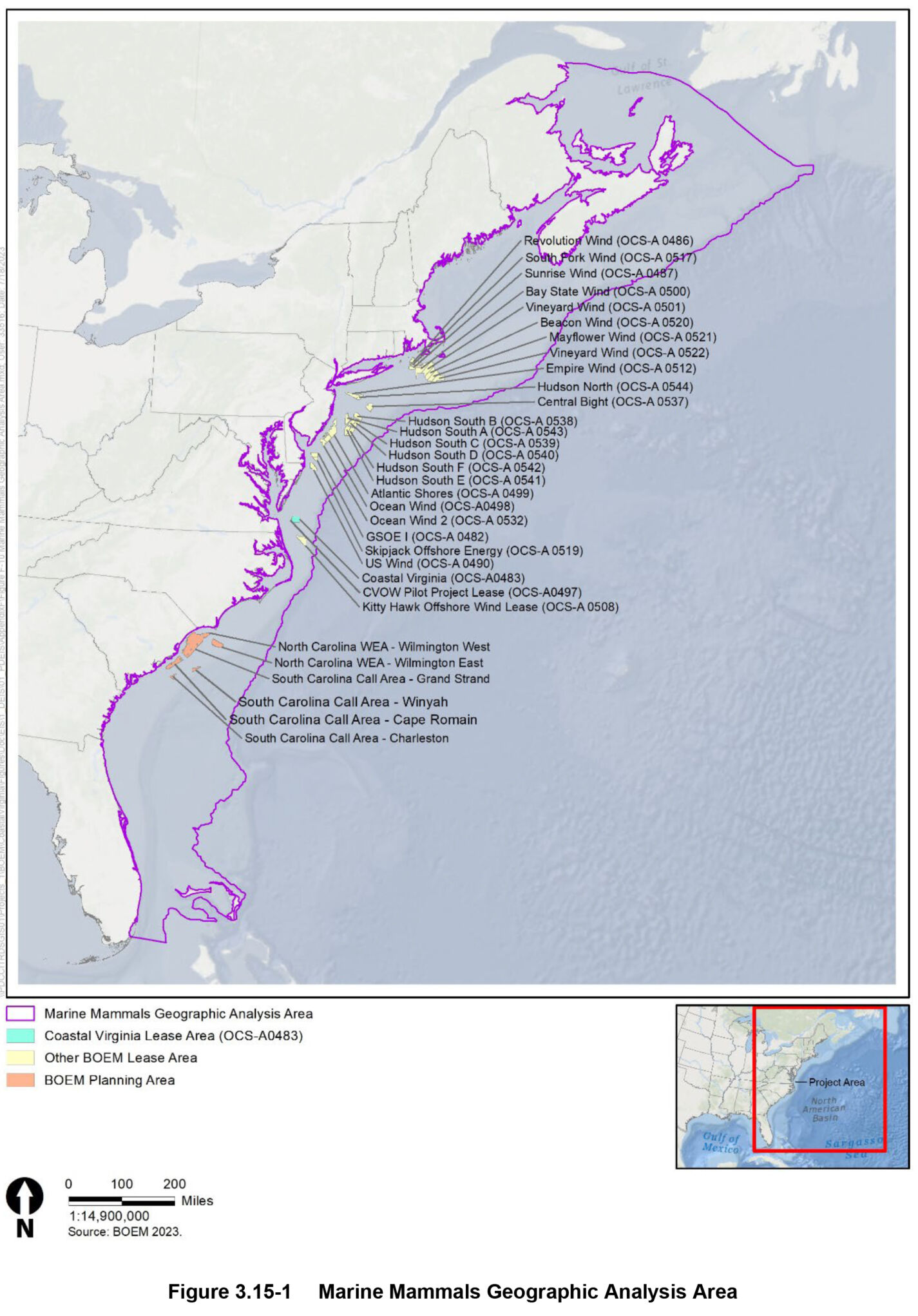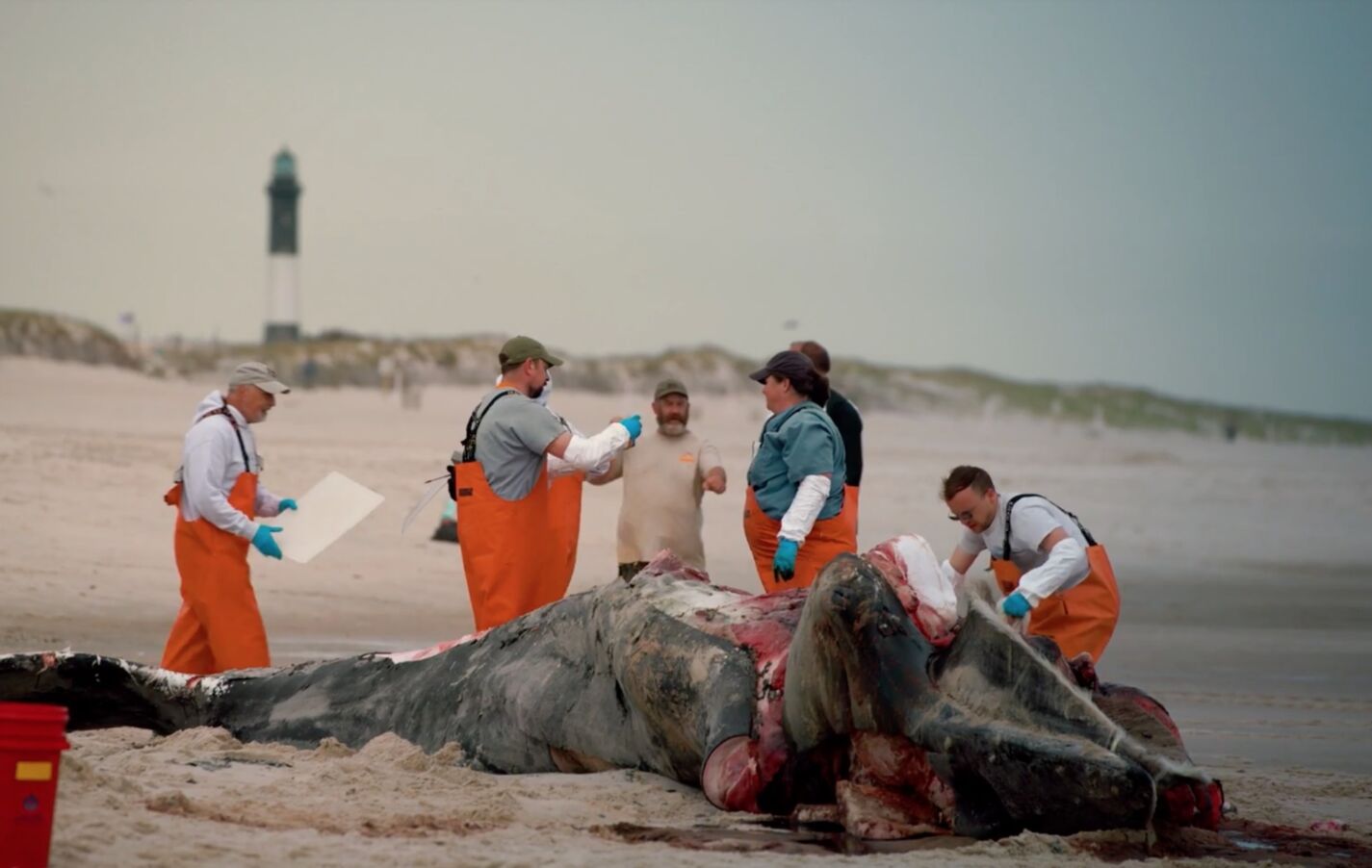- A lawsuit against a massive offshore wind project in Virginia says the project will result in far more North Atlantic Right Whale deaths than the critically endangered population can sustain
- The suit also claims that BOEM failed to meet its requirement to use the “best scientific and commercial data available”
- Among the four whale deaths found around Virginia Beach in March was a mother right whale whose orphaned calf is now expected to die
The previous brief discussed a lawsuit against the monstrous, 176-turbine Coastal Virginia Offshore Wind (CVOW) project. The suit claims, among many other things, that Biological Opinion (BiOp) issued by the National Marine Fisheries Service (NMFS) to gain approval of the project failed to account for the cumulative effects on the critical endangered North Atlantic Right Whale (NARW) population, when there are 32 offshore wind projects planned to be placed in the whales’ migratory, feeding, and calving route. Instead, it considered CVOW separate from all the others, counter to federal requirements.
This brief will discuss some of the other claims in the lawsuit from the Heartland Institute, the Committee for a Constructive Tomorrow (CFACT), and the National Legal and Policy Center.
Anticipating Project-Related Losses of Whales Well Past What Their Population Could Sustain
In 2022 the National Marine Fisheries Service (NMFS) of the National Oceanic and Atmospheric Administration (NOAA) Fisheries determined the Potential Biological Removal Rate of NARWs to be “0.7 whales.” At 0.7, it means “the population cannot sustain, on average over the course of a year, the death or serious injury of a single individual due to human causes.” Not even one whale.
In 2023 NOAA Fisheries anticipated that CVOW will result in the deaths or serious injuries of eight NARWs per year (see Table 7), as well as two fin whales (endangered), 11 minke whales (protected), and 12 humpback whales (depleted), among many other impacted species.
In 2023 NOAA Fisheries anticipated CVOW would result in the deaths or serious injuries of eight NARWs per year — a year after declaring the NARW population “cannot sustain, on average over the course of a year, the death or serious injury of a single individual due to human causes.”
In the BiOp, however, the NMFS managed to produce an Incidental Take Statement (ITS) that estimated zero whales would be as much as injured by the proposed CVOW activities.
Such a gaping discrepancy is one of the lawsuit’s examples of the “arbitrary, capricious, and unlawful” nature of the BiOp and its ITS, which it argued must be set aside along with any federal project approvals relying on it.
On March 30, a mother right whale was found dead off the coast of Virginia Beach. It was the fourth dead whale in and around Virginia Beach in the month of March. Also, her orphaned calf is expected to die.
Map of Offshore Wind Projects (Planned or Leasing) in the Endangered North Atlantic Right Whales’ Migration, Feeding, and Calving Areas

Not Following the “Best Scientific Information Available” to Keep from Jeopardizing Right Whales’ Survival as a Species
Another claim in the lawsuit is that the BiOp did not meet its requirement under the Endangered Species Act to use the “best scientific and commercial data available” to make sure the project would not “jeopardize the continued existence of any endangered species or threatened species” or harm or destroy an endangered species’ habitat. The required 60-Day Notice of Intent to Sue letter sent to the U.S. Bureau of Ocean Energy Management (BOEM), NMFS, et al. by CFACT and Heartland provided details.
According to the letter from David P. Hubbard of Gatzke Dillon & Balance, LLP, “BOEM has admitted that when the noise regulations for the NARW were promulgated, the noise parameters for baleen whales were ‘virtually unknown’ and ‘almost non-existent.’” Calling it their “#1 information need,” BOEM commissioned several studies — but not one study has been concluded.
The many studies of baleen whale hearing capabilities that were recommended in the “BOEM and NOAA Fisheries North Atlantic Right Whale and Offshore Wind Strategy” document are still all “ongoing.” A series of studies co-funded with the U.S. Navy, “Auditory Weighting Function for Low-Frequency Whales,” is also “ongoing and not due for completion until 2025.”
BOEM suggests that the real problem with this lack of knowledge could be “potential over-estimation of takes and/or effects and improper application of mitigation.” BOEM makes it seem as if the issue with not knowing anything about what could damage the whales’ hearing could mean they might do too much to protect the whales.
Of course, it’s equally likely there could be potential underestimation of takes [whales killed, injured, or harassed] and not enough mitigation. Equal likelihood, but unequal end results. The end result of overestimation would be fewer vastly expensive, unreliable, and unsightly offshore wind facilities built, leaving coastal communities and electricity consumers better off. The end result of underestimation, however, would be extinction. Plus electricity consumers and coastal communities would also be worse off.
The letter explained,
Because BOEM admitted that it based its regulations on outdated and incomplete data, without satisfying this “number one information need,” the BiOp’s conclusion that “[n]o mortality or permanent injury (auditory or other) is expected from exposure to any aspect of the proposed action” (p. 216) is arbitrary and capricious.
Again, CVOW is far from the only project the whales will encounter. The letter noted that “NMFS issued 163 ‘Level B take’ permits for the NARW” to offshore wind project developers up and down the East Coast, affecting “more than 50% of the entire estimated NARW population of 350 animals.” (Level B take permits allow permittees to “disturb marine mammal stock by causing disruption of behavioral patterns, including migration, breathing, nursing, breeding, feeding or sheltering.”) Worse, the 163 take permits fail to “take into account the Level B harassment authorizations for construction-related noise” from all the projects in the whales’ migratory, feeding, and calving path.

By obvious implication, the same individual whales would suffer successive impacts from each project as they encounter them in migration.
The letter noted that, in addition to ignoring the effects of construction-related noise, including “soft start” pile driving, on the whales, the BiOp “fails to acknowledge, much less assess, the impacts of pushing NARW out of the project area into waters with heavy vessel traffic and significant fishing activity … [and forcing] NARW out of their preferred travel corridors and foraging zones into areas where they could be struck by vessels and/or become entangled in fishing gear — the two most prominent causes of NARW mortality and population declines.”
Considering a Preliminary Injunction
As of this writing, a federal judge has issued a delay on CVOW. The Augusta Free Press reported May 1:
Judge Loren L. AliKhan … questioned Dominion Energy on approval by the federal government for its five mitigation plans.
The judge ordered Dominion to file a status report on approval by this Friday, May 3.
She also ordered Dominion and the Biden Administration to file their response to the coalition’s lawsuit by May 6 and for the coalition to file its response by May 9.
The paper stated that the judge was “expected to rule on the preliminary injunction shortly thereafter.”
Previous: Virginia Offshore Wind Project Sued to Save North Atlantic Right Whales


